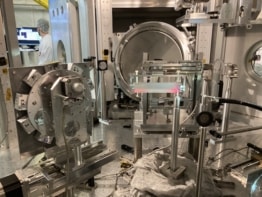
Researchers in Switzerland and the US have developed a new theoretical framework for describing a wide range of lasers — including unconventional systems called diffusive random lasers, which had hitherto defied a complete explanation. Their theory could open the door for unconventional lasers to be used in a wider range of commercial applications such as document security, remote sensing, ultra-fast displays and diagnostic imaging.
A conventional laser comprises an optical gain medium, such as a gas, that is sandwiched between two mirrors in an optical cavity. The gain medium is “pumped” using an external source of light or electric field such that most of its atoms or molecules are in higher energy excited states.
When these states decay, they emit light that bounces back and forth in the cavity. This feedback stimulates the emission of similar light from other atoms in excited states. The result is a cavity filled with unidirectional light at the same wavelength, some of which is allowed to escape to form a laser beam.
Random multiple scattering
The random laser — which does not have an optical cavity — was born in the mid-1990s, when Nabil Lawandy of Brown University in the US fired a laser beam at a beaker filled with dye that is normally used as a gain medium in a conventional laser. Lawandy found that when tiny particles of metal were added to the beaker, the dye began to lase. The laser is random in the sense that the feedback for the photons generated in the dye is provided by the random multiple scattering of light from the particles.
But exactly why this was happening was a mystery — particularly because the addition of scattering particles to a conventional dye laser was known to reduce its performance. As physicists began making random lasers utilizing different lasing media they discovered that there were actually two different kinds of random lasers.
One is the localized random laser, in which light is believed to be confined to “hot-spots” (a situation closer to that of a conventional cavity laser). The other is the diffusive random laser, or DRL, in which the particles are not very reflective. In a DRL the light effectively seeps out of the medium rapidly, instead of being confined. This rapid escape of light is very different than what occurs in an optical cavity, leaving physicists wondering how a DRL could function as a laser.
Researchers have had some success describing a theory of localized random lasers, but an understanding of DRLs had been difficult to pin down. But now, Hakan Türeci of the Swiss Federal Institute of Technology in Zurich and Douglas Stone and Colleagues at Yale University have come up with a new general theory of lasers that explains the operation of both types of random laser as well as more conventional lasers (Science) .
Extreme leakiness
The team used their theory to create computer simulations that can model the extreme leakiness of a DRL and determine a number of key parameters of the laser including its output power and the wavelengths of the laser light emitted. Inputs to the simulation include the distribution of scattering particles in the medium and the pumping power.
Their model considers all possible ways that light can reflect back and forth in the medium (its resonant modes) and works out how these modes interact with each other to define the wavelengths of the light that is produced by the laser.
Using the simulation, the team was able to reproduce a key feature of DRLs that had eluded previous theories – that the wavelengths of the laser light emitted are always the same, no matter how the DRL is pumped.
The team is currently using their theory to understand the stability of the output wavelengths. Türeci is also confident that the theory will be used to boost the performance of other unconventional lasers such as those based on chaotic resonators or photonic crystal-based cavities.
Random lasers have already been used by Nabil Lawandy to create a document security system whereby a liquid containing reflective particles is “painted” onto a piece of paper. When the material dries, it can be made to emit laser light by firing a laser at it. The precise wavelengths of the light emitted are defined by the exact locations of all the reflective particles in the dried paint — something that is different for each daub. The result is a unique signature that cannot be reproduced.



